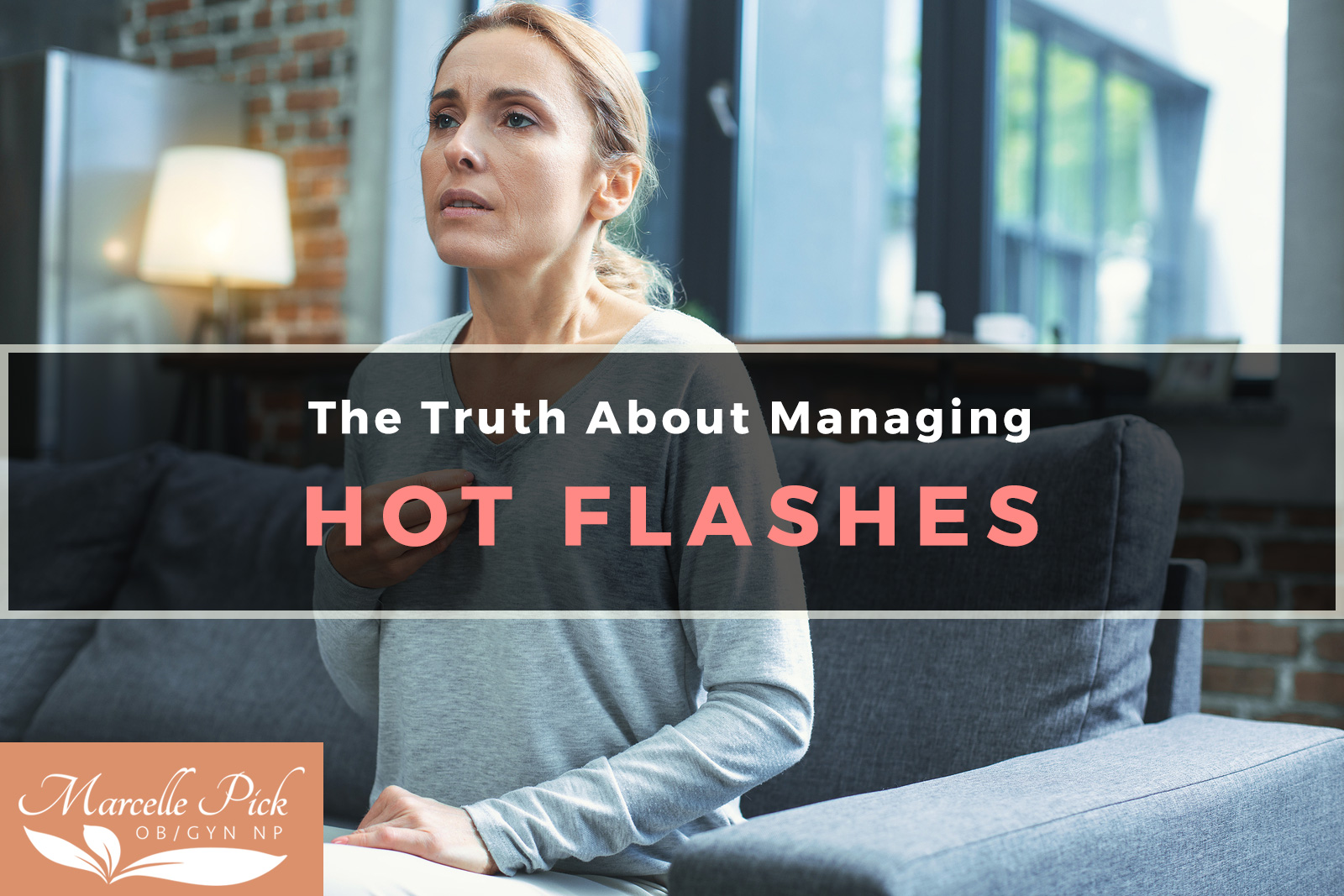I’m thrilled to say that it’s been awhile since I have had to think about hot flashes, but I remember those days well. And I can easily relate to the difficulties hot flashes present when my patients tell me their stories. One of my patients shared this story about one of her friends. She was dining out at a Mexican restaurant with her daughter and baby granddaughter. The combination of the spicy food, sangria, the stress of the irritable baby and watching her daughter trying to nurse in a crowded noisy space was enough to give any woman a hot flash. She began experiencing intense hot flashes so she left the restaurant without even saying a word to her daughter, ran out to her car and turned the A/C on full blast!
This story reminded me that just as a nursing baby is affected by what its mother eats, because the food is passed to the baby through their mother’s milk, we too are affected by the foods and drinks that we put into our bodies. There is a wealth of great advice about how to deal with the symptoms of menopause, but you don’t hear much about how food can be your greatest ally in combating many menopausal symptoms. Certain foods can calm us or make us more irritable, or simply push us off-balance.
Through working with thousands of women, we’ve observed that specific foods and drinks do seem to bring on hot flashes and night sweats, while others work well to subdue them. This information might leave you asking, “What is the best way to eat when you’re dealing with hot flashes?”
Hot Flashes Diet
Let’s take a closer look at how foods affect the continual balancing act that occurs between your major and minor hormones. Learn the right foods for a hot flashes diet so that you can minimize the intensity and frequency of your hot flashes — and enjoy nourishing, delicious meals in peace.
Protein — the Foundation for Hot Flashes Diet
Our bodies involve a complicated balance of hormones that are greatly affected by our environment and the foods that we ingest. Healthy hormonal and emotional balance can be achieved by ingesting healthy foods. These nutritious foods can provide not only good information for our bodies, they also supply all the raw materials your neuroendocrine (nerve–hormone) needs to support this crucial balance. Protein is one of the raw materials required to make and balance hormones, so it is wise to include some with each meal and snack that you eat. I explain why protein is so important in my book Is It Me or My Hormones?
Snack Foods and Beverages for Hot Flashes Diet
When you need a snack, don’t reach for processed junk food. Instead, try nibbling on or sipping the following, which can help you get started on resetting your hormonal balance.
- Roasted soy nuts — look for non-GMO, with sea salt or other natural seasonings
- Raw broccoli, cauliflower, and celery sticks dipped in Creamy Tofu-Garlic Dip (see recipe below)
- A bowl of old-fashioned oatmeal, topped with 3 tablespoons freshly ground flax seeds and soy milk
- Broccoli sprouts, generously sprinkled atop a salad or tucked inside a whole grain wrap or omelet
- Icy soy smoothie, blended with your choice of deeply-pigmented berries
- Soothing chamomile tea, iced or freshly steeped
“Humans need a steady source of protein for the constant rebuilding that goes on within the body, including hormone production. Without protein the body ceases to regenerate, and hormone production declines and/or becomes imbalanced.” – Dr. Diana Schwarzbein in The Schwarzbein Principle.
A simple and easy way to increase your protein intake is it to add whole, non-GMO soy foods to your diet. You will also reap the sizeable benefits soy isoflavones have to offer menopausal women. We understand, though, that soy is not for everyone, but when it comes to quelling vasomotor symptoms, we’ve seen such favorable results that we regard soy as a menopausal superfood. We regard it so highly that we often suggest a smoothie for breakfast that includes a soy shake.
Some other wonderful sources of plant-based protein include:
- Freshly crushed flax seeds
- Nuts and nut butters (like almond butter or cashew butter)
- Lentils and other legumes
These foods offer protein, healthy fats, and fiber, as well as additional phytochemicals that your body needs to synthesize, properly metabolize, and balance hormones. Wild-harvested seafood and organic/grass-fed meats, eggs, and yogurt are great examples of quality sources of animal proteins and healthy fats.
Creamy Tofu-Garlic Dip
Ingredients:
1 14-oz tub of soft or silken tofu
2 tsp toasted sesame oil
1 Tbsp cider vinegar
½ tsp dry mustard
½ tsp iodized sea salt
1 tsp tamari or soy sauce
2 cloves of garlic
Instructions:
Whip all ingredients in a blender or food processor, transfer to a covered glass refrigerator dish, and chill.
Use as a dip for your favorite raw or steamed veggies, chips, or pita.
Healthy Fats — How They Help
Believe it or not, women need fat to support hormonal balance in menopause! I want to reassure you that eating healthy fat won’t make you fat. Cholesterol is an important type of fat that comes in different forms — not all of which are “bad.” Cholesterol serves as the mother molecule to all our steroid hormones — both sex hormones and stress hormones.
We also can’t live without the essential fatty acids (EFA’s), because essential fatty acids are healthy hormone-balancing fats. Olive oil, nuts, fatty fish like salmon, and avocado are all examples of foods that are rich in these EFAs. In order to prevent symptoms like hot flashes, we must have balance between all our hormones. Research suggests that omega-3’s in particular can help diminish the frequency of a woman’s hot flashes. For more information and to learn more about the truth about fat, cholesterol, and omega-3 fatty acids, read our article Balancing Your Omega-3 Fatty Acids – Essential For Health and Long Life.
High-Fiber Phytonutrients — Fewer Flashes
For women with hot flashes, it is very important to include fruits and vegetables into their everyday diet. If we take a closer look as to why, we see that the fiber they contain is completely indispensable to a woman’s digestion, healthy weight, and yes, hormonal balance. Fiber not only “keeps things moving,” it’s the preferred food of your GI flora. Feed them well and they’ll help you properly absorb nutrients and metabolize your sex hormones. Fiber also prevents you from having sharp spikes of insulin. Insulin is one of the body’s major hormones, so once it is in check, it makes balancing all of your other hormones, especially in menopause, that much easier.
“Phytochemicals” are a component of many fruits and vegetables that are essential to women in perimenopause and menopause. These wonderful, helpful phytochemicals are just one part of fruits and vegetables; the most important for women are those that contain phytoestrogens. These are the plant kingdom’s version of a woman’s estradiol, but they are not estrogen molecules. They also don’t increase a woman’s own estrogen, but instead gently work with your body to recalibrate balance at the cellular level. We explain and illustrate this adaptogenic, protective mechanism in our articles on phytotherapy for hormonal balance.
The types of phytoestrogens best known for their potential to reduce menopause symptoms and reduce disease risk include isoflavones, lignans, and coumestans. As noted above, soybeans are a classic example of an isoflavone rich food. The menopausal super food most abundant in lignans is flax seed. We recommend 1–3 tablespoons a day, always freshly ground, stirred into soups, salads, smoothies, or porridges. To enjoy the benefits of coumestans, brew up some red clover tea in the evenings. This also helps you to sleep. You can also enjoy them on top of your salads with alfalfa sprouts. Phytoestrogens are also found in members of the parsley family, such as fennel and celery, as well as garlic, onions, and all sorts of seeds, nuts and legumes.
Broccoli for Hormonal Balance?
The antioxidant compound known as sulforaphanes is especially potent in young broccoli sprouts. It is theorized that by activating phase II detoxification enzymes, sulforaphanes help balance the hormonal estrogen scales There are current studies looking at how the body metabolizes estrogen, and linking this to breast cancer, not the estrogen levels themselves.
Another important group of vegetables is the cruciferous family:
- Watercress
- Collards
- Kale
- Cabbages
- Broccoli
- Brussel sprouts
- Cauliflower
- Radishes
All the cruciferous vegetables are ultra-rich in the phytochemicals plant scientists call glucosinolates. These sulfur-containing compounds get converted in the body — because of your digestive enzymes and friendly intestinal microflora — into potent detoxifying molecules called isothiocyanates.
You don’t need to understand the chemistry to reap the benefits, though. Simply take in a big helping of greens daily. Three-day-old broccoli sprouts top out the charts, so throw them into your salads and enjoy. By supporting your phase II detoxification pathways at the molecular level, this modest step helps balance hormones and reduces hot flashes.
Every season brings a myriad of new shapes, colors, texture, and tastes to savor at every meal. The seemingly endless variety of plant based foods is wonderful, so enjoy the abundance.
Food to Avoid for Hot Flashes Diet
Eating a diet high in white sugar, white bread, pasta, or any foods that are highly refined and/or processed will induce more hot flashes. I also warn women to also stay away from these things, which are typical hot flash triggers for many women:
- Caffeinated drinks
- Chocolate
- Red wine
- Aged cheeses
- Dishes that are deep-fried or overly spicy
To create better health and hormonal balance and reduce hot flashes I strongly suggest tapping into the endless variety of plant based foods that you can pick up at your local farmer’s market or natural food store.
There is never a “one size fits all” solution; foods that affect other women may be completely different from the foods that affect you. That’s why I suggest keeping a food journal of what and when you eat and drink, and how you feel afterward. Pick up a journal at the store, or can keep a digital journal on your computer. If you notice a connection between certain foods you love and your hot flashes or other unpleasant symptoms, save it for a special occasion. Once you’ve been symptom free for awhile, you can try it again to see if you are better able to tolerate that food. Our bodies are changing every day, and as we care for ourselves as time goes by, the better we will begin to feel. You may even see your devotion begin to shift away from certain foods and habits and more toward yourself!
Our Nutritional and Lifestyle Guidelines can provide you with further specifics on eating for hormonal balance.
Final Thoughts on the Hot Flashes Diet
Your body needs its stores of vital nutrients replenished daily, especially during hormonal transitions like menopause. A balanced diet of quality protein, healthy fats, and phytonutrient-rich fruits and vegetables, together with regular exercise, adequate sleep, and stress reduction are all that most women need to regulate healthy hormonal and neurotransmitter balance. A top-quality multivitamin-mineral complex and omega-3 supplement can not only ensure that your nutritional bases are covered for today and tomorrow, but that the inevitable swings of hormonal change are less dramatic and unpleasant. You may also benefit from a variety of delicious recipes for hormonal balance featured in my book, Is It Me or My Hormones?
For those of you who continue to experience hot flashes and night sweats, a well-formulated phytotherapeutic supplement can make all the difference. Isoflavone-rich, non-GMO soy foods can provide additional gentle endocrine support to moderate sex hormone fluctuations. A majority of women seeking natural relief from menopause symptoms find their hot flashes are reduced remarkably well with this combination approach. All through our lives our bodies engage in a constantly shifting, dynamic balancing act — which means that whether or not we’re passing through a major transition like menopause, the path to better health and balance is always within reach.
Thankfully, there are many natural ways to quiet the unwelcome symptoms of hormonal imbalance – hot flashes, night sweats, and the anxiety, irritability, fatigue, and sleeplessness that can sometimes accompany them. Nourishing yourself well with each new day is simply the easiest place to begin.









